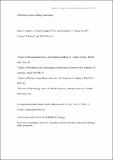Files in this item
Optimizing countershading camouflage
Item metadata
| dc.contributor.author | Cuthill, Innes | |
| dc.contributor.author | Sanghera, N. Simon | |
| dc.contributor.author | Penacchio, Olivier | |
| dc.contributor.author | Lovell, Paul George | |
| dc.contributor.author | Ruxton, Graeme Douglas | |
| dc.contributor.author | Harris, Julie | |
| dc.date.accessioned | 2017-05-02T23:34:10Z | |
| dc.date.available | 2017-05-02T23:34:10Z | |
| dc.date.issued | 2016-11-15 | |
| dc.identifier | 246780536 | |
| dc.identifier | 2b72d674-a77f-4530-9cd3-8b998012daa2 | |
| dc.identifier | 84994885332 | |
| dc.identifier | 000388970100065 | |
| dc.identifier.citation | Cuthill , I , Sanghera , N S , Penacchio , O , Lovell , P G , Ruxton , G D & Harris , J 2016 , ' Optimizing countershading camouflage ' , Proceedings of the National Academy of Sciences of the United States of America , vol. 113 , no. 46 , pp. 13093-13097 . https://doi.org/10.1073/pnas.1611589113 | en |
| dc.identifier.issn | 0027-8424 | |
| dc.identifier.other | ORCID: /0000-0002-3497-4503/work/46085834 | |
| dc.identifier.other | ORCID: /0000-0001-8943-6609/work/60427506 | |
| dc.identifier.uri | https://hdl.handle.net/10023/10697 | |
| dc.description | The research was funded by grants BB/J002372/1 and BB/J000272/1 from the Biotechnology & Biological Sciences Research Council, UK, to JMH, GDR, ICC and PGL. ICC thanks the Wissenschaftskolleg zu Berlin for support during part of the study. | en |
| dc.description.abstract | Countershading, the widespread tendency of animals to be darker on the side that receives strongest illumination, has classically been explained as an adaptation for camouflage: obliterating cues to 3D shape and enhancing background matching. However, there have only been two quantitative tests of whether the patterns observed in different species match the optimal shading to obliterate 3D cues, and no tests of whether optimal countershading actually improves concealment or survival. We use a mathematical model of the light field to predict the optimal countershading for concealment that is specific to the light environment, then test this with correspondingly patterned model “caterpillars” exposed to avian predation in the field. We show that the optimal countershading is strongly illumination dependent. A relatively sharp transition in surface patterning from dark to light is only optimal under direct solar illumination; if there is diffuse illumination from cloudy skies or shade, the pattern provides no advantage over homogeneous background-matching coloration. Conversely, a smoother gradation between dark and light is optimal under cloudy skies or shade. The demonstration of these illumination dependent effects of different countershading patterns on predation risk strongly supports the comparative evidence showing that the type of countershading varies with light environment. | |
| dc.format.extent | 5 | |
| dc.format.extent | 2814115 | |
| dc.language.iso | eng | |
| dc.relation.ispartof | Proceedings of the National Academy of Sciences of the United States of America | en |
| dc.subject | Camouflage | en |
| dc.subject | Defensive coloration | en |
| dc.subject | Animal coloration | en |
| dc.subject | Shape-from-shading | en |
| dc.subject | Shape perception | en |
| dc.subject | QH301 Biology | en |
| dc.subject | DAS | en |
| dc.subject | BDC | en |
| dc.subject | R2C | en |
| dc.subject.lcc | QH301 | en |
| dc.title | Optimizing countershading camouflage | en |
| dc.type | Journal article | en |
| dc.contributor.sponsor | BBSRC | en |
| dc.contributor.institution | University of St Andrews. School of Psychology and Neuroscience | en |
| dc.contributor.institution | University of St Andrews. Institute of Behavioural and Neural Sciences | en |
| dc.contributor.institution | University of St Andrews. School of Biology | en |
| dc.contributor.institution | University of St Andrews. Centre for Biological Diversity | en |
| dc.identifier.doi | 10.1073/pnas.1611589113 | |
| dc.description.status | Peer reviewed | en |
| dc.date.embargoedUntil | 2017-05-02 | |
| dc.identifier.grantnumber | BB/J000272/1 | en |
This item appears in the following Collection(s)
Items in the St Andrews Research Repository are protected by copyright, with all rights reserved, unless otherwise indicated.

